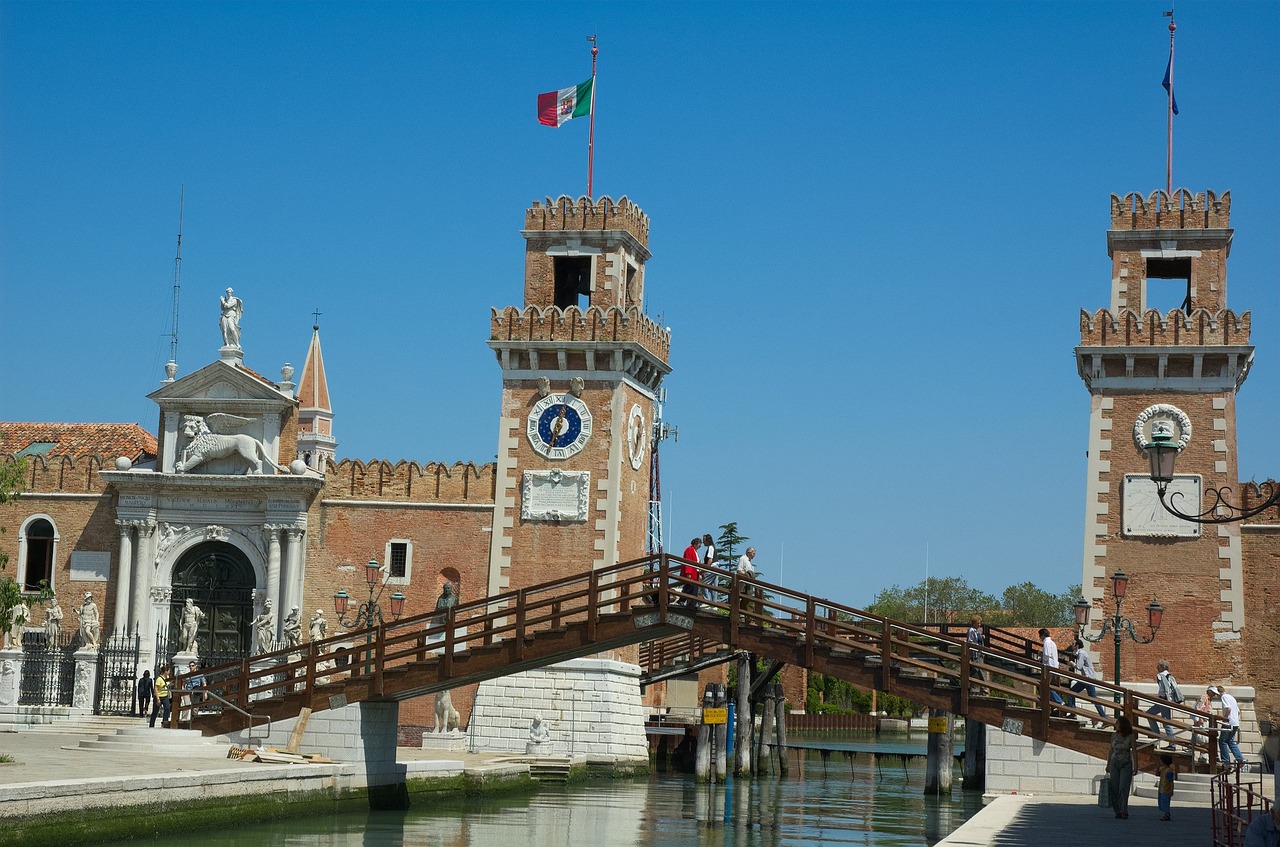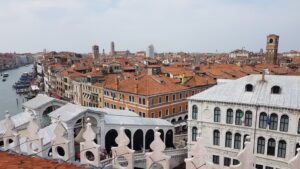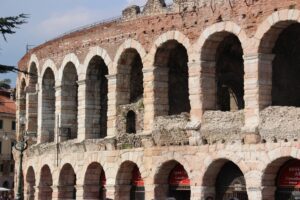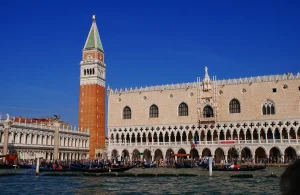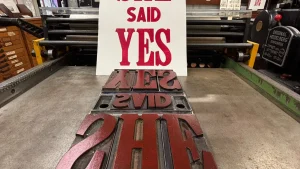⚓ The Venice Arsenal — Where Venice Built Its Maritime Empire
Hidden on Venice’s serene eastern edge lies a place that once powered an empire. The Venice Arsenal (Arsenale di Venezia) is more than a shipyard — it’s where the Republic of Venice built its strength, wealth, and legend. For centuries, these vast docks and workshops forged the ships that carried Venetian merchants, explorers, and warriors across the known world.
Today, walking through the Arsenal feels like stepping inside the city’s beating heart — where innovation met ambition, and the sea answered.
🌊 A City Written in Water
Venice was born from the lagoon, and the Arsenal was its engine. By the 13th century, the Serenissima Repubblica had become the “Queen of the Adriatic,” ruling trade routes from Constantinople to Alexandria. Its might floated on thousands of galleys built here — proof that maritime genius, not military muscle, made Venice thrive.
🏗️ A Triumph of Engineering and Organization
Founded around 1104, the Arsenal began as a small naval depot. Two centuries later it sprawled over 60 acres — a medieval industrial city inside Venice. It pioneered mass production, logistics, and supply-chain systems centuries before the Industrial Revolution.
🚢 The World’s First Assembly Line
Long before Henry Ford, Venetian shipwrights had already perfected an assembly-line method. Sixteen specialized workshops built every part — hulls, sails, ropes, weapons — simultaneously. At its peak, the Arsenal could launch a fully armed galley in 24 hours ⚙️ — an extraordinary feat for the 1400s.
⚙️ Innovation & Secrecy
The Arsenal was Venice’s Silicon Valley: a state-run lab where craftsmen tested prefabrication, standardized parts, and military engineering. Foreigners were forbidden to enter; workers swore oaths of silence. That secrecy preserved the Republic’s naval edge and economic dominance for centuries.
Did you know? The very word “arsenal” comes from the Arabic dar as-sina’ah — “house of industry.” It’s a linguistic relic of Venice’s early trade with the Islamic world.
🧭 Ships That Shaped an Empire
Every galley built here carried the Republic’s destiny. From swift merchant vessels loaded with silk and spices to mighty warships guarding convoys, each plank reflected Venetian mastery.
The Arsenal’s greatest triumph came at the Battle of Lepanto (1571), when a Venetian-built fleet helped the Holy League defeat the Ottomans. The victory echoed across Europe — proof that ingenuity could outmatch empire.
More than 16 000 “arsenalotti” — carpenters, blacksmiths, sail-weavers — worked behind these walls. Their craftsmanship sustained the Republic’s power and still defines Venetian pride today.
🛡️ Power, Politics & the Venetian Spirit
The Arsenal wasn’t just a workplace — it was the Republic’s strategic heart. The Senato Veneto controlled every nail and sail, appointing Patroni dell’Arsenale to oversee operations. It introduced early concepts of quality control, supply management, and labor organization — principles still taught in business schools today.
To be an arsenalotto meant belonging to Venice’s elite working class — disciplined, loyal, and ingenious. Their legacy lives in the city’s DNA.
🎨 The Arsenal in Art & Imagination
Dante described its “boiling pitch” in the Inferno. Painters like Canaletto, Guardi, and Carpaccio immortalized its gates crowned by marble lions. Writers from Byron to Hemingway found inspiration here — proof that industry can be poetry when framed by water and light.
🏛️ The Arsenal Today
By the 18th century, the Republic’s power waned, but the Arsenal never fell silent. Today, it remains partly a naval base and partly a cultural wonder — a bridge between past and present.
🎭 The Venice Biennale
Every two years, the Arsenal transforms into one of the most spectacular venues of the Venice Biennale. Its cavernous docks host installations from around the globe — modern creativity within medieval walls. It’s the perfect metaphor for Venice itself: ancient soul, timeless innovation.
⚓ The Naval History Museum
Next door stands the Venice Naval History Museum — a hidden gem that tells the full story of the city’s seafaring genius. Inside you’ll find ship models, navigational instruments, and the Bucintoro, the Doge’s ceremonial golden barge. Book your skip-the-line tickets in advance to avoid queues.
🧠 Fascinating Facts About the Venice Arsenal
- 🚢 Could build a 200-ton galley in under 24 hours — centuries before Ford’s factory.
- 👷 Employed one-tenth of Venice’s population at its height.
- 🦁 Two Greek marble lions guard the gate — war trophies from Piraeus.
- 📜 Introduced standardized ship components 400 years before industrialization.
- 🎨 Featured in countless artworks and even Dante’s Divine Comedy.
💬 Visiting Tips from Locals
- 🕓 Best Time: May–November during the Biennale — more areas open to the public.
- 🚶♂️ How to Get There: Vaporetto lines 1, 4.1, or 4.2 → stop “Arsenale.”
- 📸 Photo Spot: Capture the gateway at golden hour for mirror-perfect reflections.
- 🏺 Combine With: The Natural History Museum or our Lagoon Tour to see how it all connects.
- 👂 Listen for Echoes: On quiet days, you can still hear the wind singing through the old docks — the ghosts of shipbuilders past.
🌅 The Arsenal’s Legacy — Venice’s Genius in Motion
The Venice Arsenal isn’t a relic; it’s proof that creativity and discipline can move oceans. Here, technology, art, and politics blended into something larger than life — a living symbol of the Venetian spirit.
To walk its courtyards is to stand where empires launched, where ideas were forged, and where Venice continues to reinvent itself.
⚓ Explore the Arsenal with a Local Guide →
❓ FAQs About the Venice Arsenal
Can you visit the Venice Arsenal?
Yes, parts of the Arsenal are open year-round, and even more during the Venice Biennale. Join our Orientation Tour to access nearby areas few tourists reach.
What is the Venice Arsenal famous for?
It was the heart of Venice’s naval empire — the world’s first mass-production shipyard capable of launching a galley in a day, centuries before modern factories.
Where is the Venice Arsenal located?
On the city’s eastern side near the Castello district. Reach it easily by Vaporetto or on our Venice Lagoon Tour — the same waters once sailed by the Republic’s fleet.

